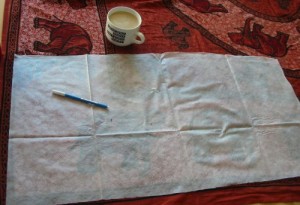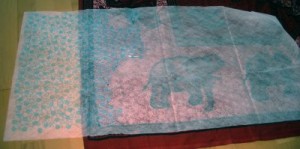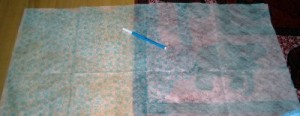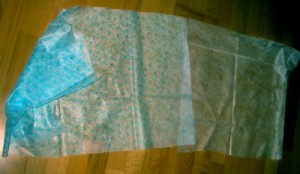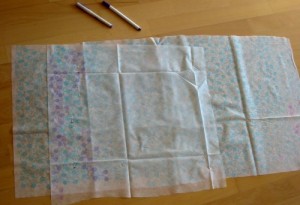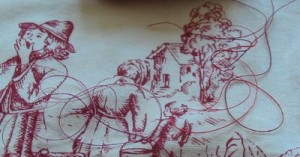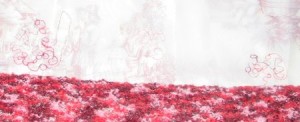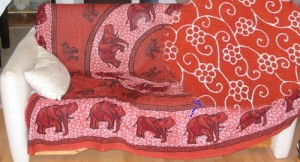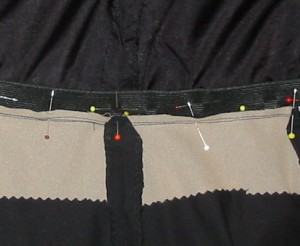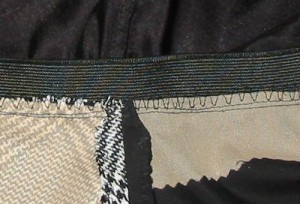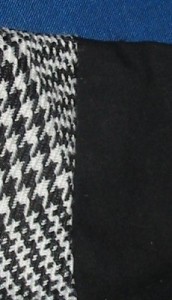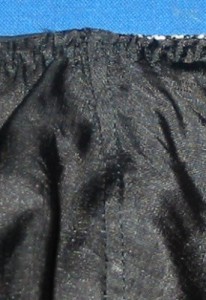…und das seit einer guten Woche.
Nun gut, ich habe auch noch ein bißchen was anderes gemacht, arbeiten etwa. Aber meistens habe ich gestickt. Wenn ich mich nicht gerade selber für meine Idee verflucht habe. 😮
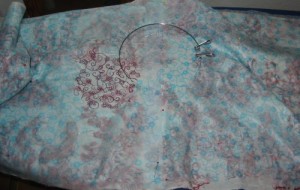 Das Soluvlies mit der Vorzeichnung habe ich leicht überlappen auf dem Stoff festgesteckt. Da ich mit einem Stickring arbeite und der Stoff nicht elastisch ist, muß ich es nicht fest fixieren.
Das Soluvlies mit der Vorzeichnung habe ich leicht überlappen auf dem Stoff festgesteckt. Da ich mit einem Stickring arbeite und der Stoff nicht elastisch ist, muß ich es nicht fest fixieren.
Als ich mit der Vorzeichnung fertig war, war es schon wieder gegen Abend, aber zumindest einen Ring mußte ich noch absticken. Ich arbeite in etwa von der Mitte nach außen, wobei ich etwas nach rechts versetzt beginne, weil ich die Stelle, an der die beiden Sulovliesstück überlappen möglichst bald überstickt und somit auch gesichert haben will. Die zweite Stickfläche setze ich dann auch schon auf den Überlapp.
Ich benutze den großen Stickring von Madeira, der hat einen Durchmesser von ca 18 cm. Je größer der Ring ist, desto weniger Stabilität bekommt der Stoff und desto schwieriger ist er auch zu führen. Zumal der Durchlass meiner Maschine ein paar Milimeter kleiner ist als der Außendurchmesser des Ringes, so daß ich schon mal anstoße, wenn ich ganz an der linken Kante des Ringes arbeite. Aber wenn ich irgendeine Chance haben will, rechtzeitig fertig zu werden, dann muß die Perfektion jetzt mal drei Schritte zurück treten. Hier soll es ja nur auf den Gesamteindruck ankommen, nicht die Stickerei im Detail.
After all that tracing I can finally start stitching. What I’m doing since.. well… since I completed tracing last week. :o)
The Soluvlies just gets pinned on my fabric. As I’m working with a hoop glueing oder basting is not necessary. To have any chance to finish in time I’m using the biggest hoop I have (from Madeira with a diameter of about 18cm). The disadvantages are, that the bigger the hoop the less stability of the fabric. Luckily this fabric isn’t elastic at all and not to soft either, so it will to. Of course it’s also more diffcult to move the big hoop precicely than doing the same thing with a smaller one. And the hoop is a fraction larger than my machine has room, so if i’m working on the very left border of it, it bumps to the machine on the right side which does not at all help to stitch where I want to stitch. But… time’s a matter here, so compromise is better than going naked… 😉
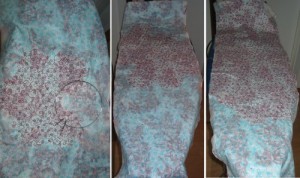 Another difficult thing was the handling of the threads. Frankly… both of them together fed into the tension system… was a little more than what a household sewing machine is supposed to use. And mine was set to work best with fine threads (by the mechanic on my demand), because that’s what I’m using most.
Another difficult thing was the handling of the threads. Frankly… both of them together fed into the tension system… was a little more than what a household sewing machine is supposed to use. And mine was set to work best with fine threads (by the mechanic on my demand), because that’s what I’m using most.
As my design has very round forms, it would be best to make the stitches as small as possible. But as the thread is rather thick it catches somewhere in the bobbin, if the stitches are small… Finding an appropriate needle wasn’t easy either. The largest embroidery needle I have is a size 90 (Titanium from Organ). One. So no needle break please, because I don’t know where to buy these locally…?
Next I learned a lot about cotton thread I think I haven’t been using any for ages. And never stitched so much with it. One lesson is: cotton creates much more lint everywhere in the machine than my usual polyester thread.
Second lesson was: when you work quite at the edge of the machines specification (or even a bit beyond…) use quality thread. On the bobbin, too.
On the bobbin I’m using ususally a cheap, thin, white polyester thread I bought really verry cheap quite long ago. (In quite big amounts, of course…) No, I wont do that again. But so far it worked well for embroidery.
Well, here it didn’t. I had a lot of birds nests, the Valdani thread would catch somewhere under the stitch plate… Okay, part of it is due to the fact, that the two threads are to thick for the machine. But after I replaced the cheap thread by a simple white Gütermann it went much, much, much better. So over the days I made some progress, as the pictures show…
Als Oberfaden verwende ich zwei Rollen des handgefärbten Valdani-Baumwollgarns, die ich gemeinsam durch die Oberfadenspannung und die Nadel laufen lasse. Ehrlicherweise muß ich sagen, daß das Garn so eigentlich zu dick für meine Maschine ist. Um so mehr, weil ich sie bei der letzten Wartung auf dünne Fäden habe optimieren lassen, weil ich diese ja am häufigsten verarbeite. Der nächste Haken ist, daß mein Muster ja recht viele Rundungen hat. Diese stickt man am schönsten mit möglichst kleinen Stichen nach. Das dicke Garn jedoch verlangt lange Stiche, sonst gibt es Fadensalat… Kompromisse, Kompromisse,… Ebenso die Nadel. Die dickste Sticknadel die ich habe ist eine 90er Titan von Organ (natürlich genau eine…. also bitte kein Fadenbruch, denn ich hae keine Ahnung, wo ich die hier vor Ort bekommen könnte?). Nun ja, etwas Stärker wäre besser, glaube ich. (Gibt es überhaupt Sticknadeln in 100?)
Trotzdem gibt es Fortschritte, wie die Bilder zeigen. Langsame.
Eine deutliche Verbesserung hatte ich übrigens, als ich das billige Polyestergarn, das ich als Unterfaden verwendet habe (habe ich vor langer Zeit mal megabillig geschossen, natürlich in größerer Menge, und es taugt wirklich nichts – nein, seither kaufe ich so was auch nicht mehr – aber als Unterfaden zum Sticken funktionierte es bislang ganz gut, dachte ich wenigstens…) durch ebenso simples weißes von Gütermann ausgetauscht habe. Gut, Lektion gelernt. Auch wenn es sonst immer funktioniert hat… bei Problemen Billiggarn ersetzen.
Eine andere Lektion war: Baumwolle fusselt deutlich mehr als meine Polyestergarne. (Allmählich verstehe ich, warum die Patcherinnen und Quilterinnen so versessen aufs Maschine putzen sind…. mit Baumwolle setzt sich da wirklich mehr ab.) So oft habe ich meine Maschine glaube ich noch nie sauber gemacht…
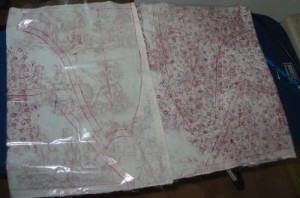 Irgendwann war der Stoff dann mal zu großen Teilen bestickt.
Irgendwann war der Stoff dann mal zu großen Teilen bestickt.
(Ich habe mich deswegen dafür entschieden, den ganzen Stoff zu besticken und nicht nur die Konturen der Schnitteile, weil ohnehin kaum etwas ungenutzt bleiben wird. Und sollte ich irgendwo in meinem Outfit doch noch ein Schnipselchen von diesem Stoff einarbeiten wollen… nachträglich ist die Stickerei nicht mehr aufzubringen.)
Daß ich die beiden Schnittkanten komplett besticken muß war mir klar, da werden die Schnitteile angelegt. Aber an den Schmalseiten kann ich vielleicht ein bißchen was sparen, deswegen mal eine Kontrollauflage meiner Schnitteile. – Doch, ein paar Ecken kann ich weglassen.
Before I finished the embroidery I decided to check, where I could maybe leave some of the borders without stitches. Saves money and material.
So I put on my pattern pieces to check… and…. yes, there are some corners I can just leave as they are…
Why I decided to stitch the whole fabric and not only the pattern pieces? Well… first of all there is not much fabric that will remain anused. And second: I haven’t decided about the design of my jacket. So it is very well possible, that I want tu use a scrap of that fabric in the jacket too. But after it’s cut it’ll be (nearly) impossible to reproduce the same embroidery.
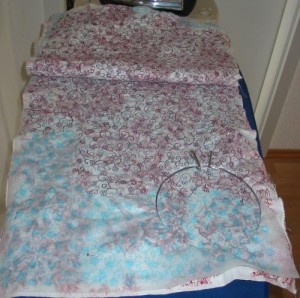 But now, slowly, I can see some light…
But now, slowly, I can see some light…
Except for the problem that I am way from my time schedule… the stitching should come to an end before the weekend actually starts.
Only there’s a new threat in sight… there is not much thread left… :o)
And since I bought the last spools in this two colours… I cannot just buy more. 🙁
So keep your fingers cross…. PLEASE!
Aber so allmählich kommt Licht am Ende des Tunnels in Sicht.
Abgesehen davon, daß ich meinem Zeitplan weit hinterher hinke, nähert sich die Stickerei ihrem Ende. Und sollte noch fertig werden, bevor das Wochenende wirklich los geht.
(Und ich kann nächste Woche dann vielleicht auch mal die Presseschau nachliefern. Die Burda PLUS liegt hier schon rum und mal sehen, ob ich heute noch dazu komme, das neue Monatsheft der Burda zu holen…)
Vorausgesetzt… vorausgesetzt der Faden reicht noch. :o)
Denn natürlich waren es die beiden letzten Röllchen in diesen Farben, die ich Silvia abgekauft habe. Auch auf den kleinen Spulen ist nichts mehr davon da…. Also kann ich nicht nachkaufen…
Also drückt mir die Daumen, bittebittebitteeee…!

